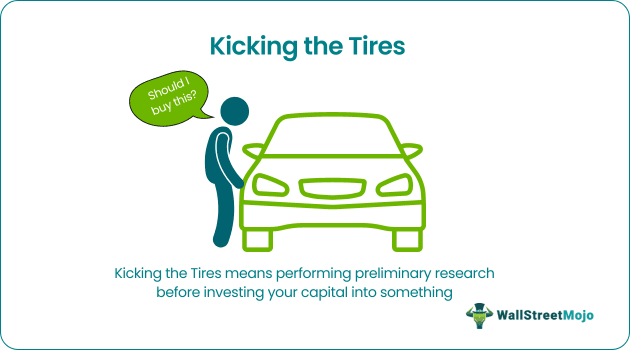Table Of Contents
Frequently Asked Questions (FAQs)
Where does the expression “Kicking the Tires” come from?
What are the advantages and disadvantages of Kicking the Tires?
What does Kicking the Tires mean in the investment world?
Is Kicking the Tires good or bad?
Kicking the Tires Meaning
Kicking the tires is an idiomatic phrase that implies conducting a basic investigation before making an investment decision. It helps you put your funds in the right direction without wasting much time and effort. Usually, it is the first step towards identifying the investments worthy of detailed analysis.

It involves carrying out a primary analysis like reading the company prospectus, going through its financial statements, and consulting with your financial advisor. Note that it is not a proven method to anticipate the outcome of a financial decision. Rather, this catchphrase is used to assist you in weighing the pros and cons of a potential investment.
Key Takeaways
- Kicking the tires means performing preliminary research before investing your capital into something.
- This phrase originates from automobile shopping and is used while considering the benefits and drawbacks of a potential investment.
- It aids you to make a smart financial decision and, at times, sets the beginning of an extensive analysis leading to interesting discoveries.
- Kicking the tires haphazardly may result in poor investment choices and immense capital loss. So, narrow down your options before applying the method.
Kicking the Tires Explained
Kicking the tires refers to the cautious initial testing of a prospective investment to check if the expected standards are met. In other words, it lets you evaluate the related risks and benefits to take a mindful business decision.
In terms of investment, this approach entails:
- Visiting the firm
- Assessing its annual reports
- Reviewing news articles about the company
- Going through its balance sheet
- Checking the income statements
- Examining the cash flow statements
- Discussing the research reports
- Observing the price-earnings ratio
This expression is derived from the usual practice of checking an automobile's quality by kicking its front tires. In the context of investing, it involves analyzing investments like securities, bonds, mutual funds, stocks, Exchange Traded Funds (ETFs), and even real property.
It permits you to do an initial evaluation of your investment before making a final commitment. A tire-kicker employs all primary sources to peek into a firm’s financial condition. The result of this practice is to comprehend to the best possible extent how the current investment will affect you in the long run.
Note that it contradicts an in-depth analysis where every minute detail is considered. Needlessly, the more well-informed you are, the more profits you will gain! Thus, relying only on this approach and basing your financial decisions solely on it may be a risky proposition. It may lead you to bad investment decisions.
The ideal scenario may be to pick investments worth pursuing using this approach. And then, conduct a thorough analysis of them before selecting the best. It will help you separate the wheat from the chaff in the least possible time.
Thus, clubbing this technique with a detailed analysis of select options will save you considerable time and protect you from the risk of investing in unprofitable investments.
Examples
Suppose a chef named Bob wants to invest in a restaurant chain called “Cravings & Delights.” So, he starts kicking the tires by looking at its past, present, and expected future market performance.
It comprises:
- Examining its past track record
- Reading the latest news articles about the company
- Checking customer testimonials and its mobile app rating
- Visiting the restaurant himself
- Interacting with the employees
- Scanning its share market performance over the years
- Scrutinizing the balance sheets and income statements
- Analyzing its market growth rate
- Discussing with his financial consultant
An initial evaluation of his investment decision will make him feel confident about pursuing it further. Of course, it does not reveal enough to make a final call. However, it assists him in making a quick-yet-efficient check on everything required to take the plunge.
He now has a somewhat idea of what lies ahead. So, naturally, he may easily decide to drop the idea if it seems unlucrative. But on the other hand, if he finds the prospects rewarding, he may conduct comprehensive research, if required, before diving in.
A recent NASDAQ article recommends investors kick the tires of the stocks of three companies: Crocs, Zoom Video Communications, and Toast. According to the article, these stocks are trading at a lower price and will likely be big winners in 2022.
With the acquisition of footwear maker Hey Dude Shoes, Crocs is expected to trade at a premium soon. In addition, the stock prices of both Zoom and cloud-based restaurant software company Toast are also ripe as the businesses are anticipated to prosper with the COVID pandemic showing no signs of receding. Thus, investors may conduct primary research and invest in them in time to reap gains later.
Advantages & Disadvantages
Advantages
- A quick examination of pros and cons
Kicking the tires allows you to instantly probe the merits and demerits of a potential investment. It ensures that you put your money, energy, and time in the right direction.
This way, you can decide not to finance something seemingly dubious. It saves you from a major monetary loss. Conversely, you can confidently put your money into a company with impressive financial performance and gain long-term benefits.
- Marks the onset of a deep-rooted analysis
The detailed research generally stems from kicking the tires. However, as an intrigued investor, you may go from just kicking the tires to administering an in-depth study. It brings some fascinating and unacknowledged discoveries which may be crucial to your decision-making.
Therefore, use this technique to condense your pool of profitable investment options and then perform a comprehensive assessment of each to zero in on the best.
Disadvantages
- Poor investments
It is a smart strategy to be used appropriately. However, you must know how and when to use it for assured results. Constantly doing it without proper know-how may result in poor investments. It provides inconsistent results and a portfolio of assets with no good returns.

